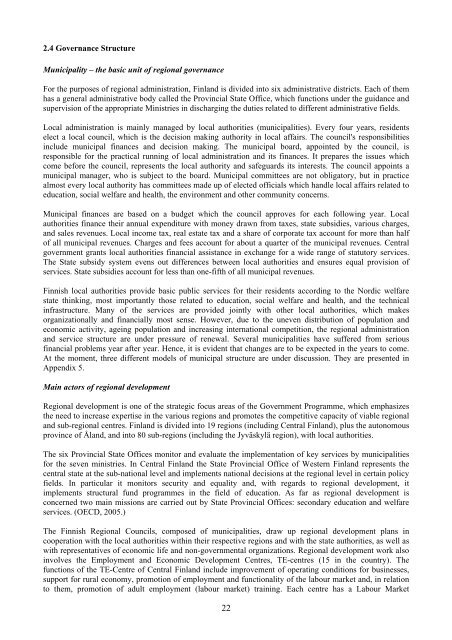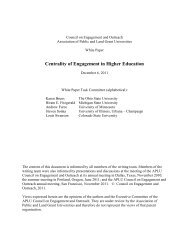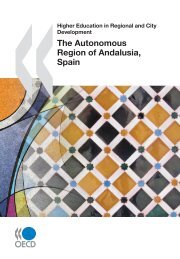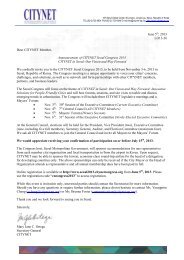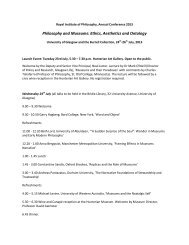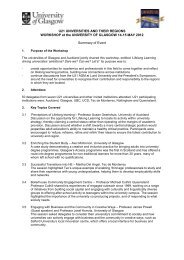Finland - Jyvaskyla Region - Final Self-Evaluation Report.pdf
Finland - Jyvaskyla Region - Final Self-Evaluation Report.pdf
Finland - Jyvaskyla Region - Final Self-Evaluation Report.pdf
Create successful ePaper yourself
Turn your PDF publications into a flip-book with our unique Google optimized e-Paper software.
2.4 Governance StructureMunicipality – the basic unit of regional governanceFor the purposes of regional administration, <strong>Finland</strong> is divided into six administrative districts. Each of themhas a general administrative body called the Provincial State Office, which functions under the guidance andsupervision of the appropriate Ministries in discharging the duties related to different administrative fields.Local administration is mainly managed by local authorities (municipalities). Every four years, residentselect a local council, which is the decision making authority in local affairs. The council's responsibilitiesinclude municipal finances and decision making. The municipal board, appointed by the council, isresponsible for the practical running of local administration and its finances. It prepares the issues whichcome before the council, represents the local authority and safeguards its interests. The council appoints amunicipal manager, who is subject to the board. Municipal committees are not obligatory, but in practicealmost every local authority has committees made up of elected officials which handle local affairs related toeducation, social welfare and health, the environment and other community concerns.Municipal finances are based on a budget which the council approves for each following year. Localauthorities finance their annual expenditure with money drawn from taxes, state subsidies, various charges,and sales revenues. Local income tax, real estate tax and a share of corporate tax account for more than halfof all municipal revenues. Charges and fees account for about a quarter of the municipal revenues. Centralgovernment grants local authorities financial assistance in exchange for a wide range of statutory services.The State subsidy system evens out differences between local authorities and ensures equal provision ofservices. State subsidies account for less than one-fifth of all municipal revenues.Finnish local authorities provide basic public services for their residents according to the Nordic welfarestate thinking, most importantly those related to education, social welfare and health, and the technicalinfrastructure. Many of the services are provided jointly with other local authorities, which makesorganizationally and financially most sense. However, due to the uneven distribution of population andeconomic activity, ageing population and increasing international competition, the regional administrationand service structure are under pressure of renewal. Several municipalities have suffered from seriousfinancial problems year after year. Hence, it is evident that changes are to be expected in the years to come.At the moment, three different models of municipal structure are under discussion. They are presented inAppendix 5.Main actors of regional development<strong>Region</strong>al development is one of the strategic focus areas of the Government Programme, which emphasizesthe need to increase expertise in the various regions and promotes the competitive capacity of viable regionaland sub-regional centres. <strong>Finland</strong> is divided into 19 regions (including Central <strong>Finland</strong>), plus the autonomousprovince of Åland, and into 80 sub-regions (including the Jyväskylä region), with local authorities.The six Provincial State Offices monitor and evaluate the implementation of key services by municipalitiesfor the seven ministries. In Central <strong>Finland</strong> the State Provincial Office of Western <strong>Finland</strong> represents thecentral state at the sub-national level and implements national decisions at the regional level in certain policyfields. In particular it monitors security and equality and, with regards to regional development, itimplements structural fund programmes in the field of education. As far as regional development isconcerned two main missions are carried out by State Provincial Offices: secondary education and welfareservices. (OECD, 2005.)The Finnish <strong>Region</strong>al Councils, composed of municipalities, draw up regional development plans incooperation with the local authorities within their respective regions and with the state authorities, as well aswith representatives of economic life and non-governmental organizations. <strong>Region</strong>al development work alsoinvolves the Employment and Economic Development Centres, TE-centres (15 in the country). Thefunctions of the TE-Centre of Central <strong>Finland</strong> include improvement of operating conditions for businesses,support for rural economy, promotion of employment and functionality of the labour market and, in relationto them, promotion of adult employment (labour market) training. Each centre has a Labour Market22


